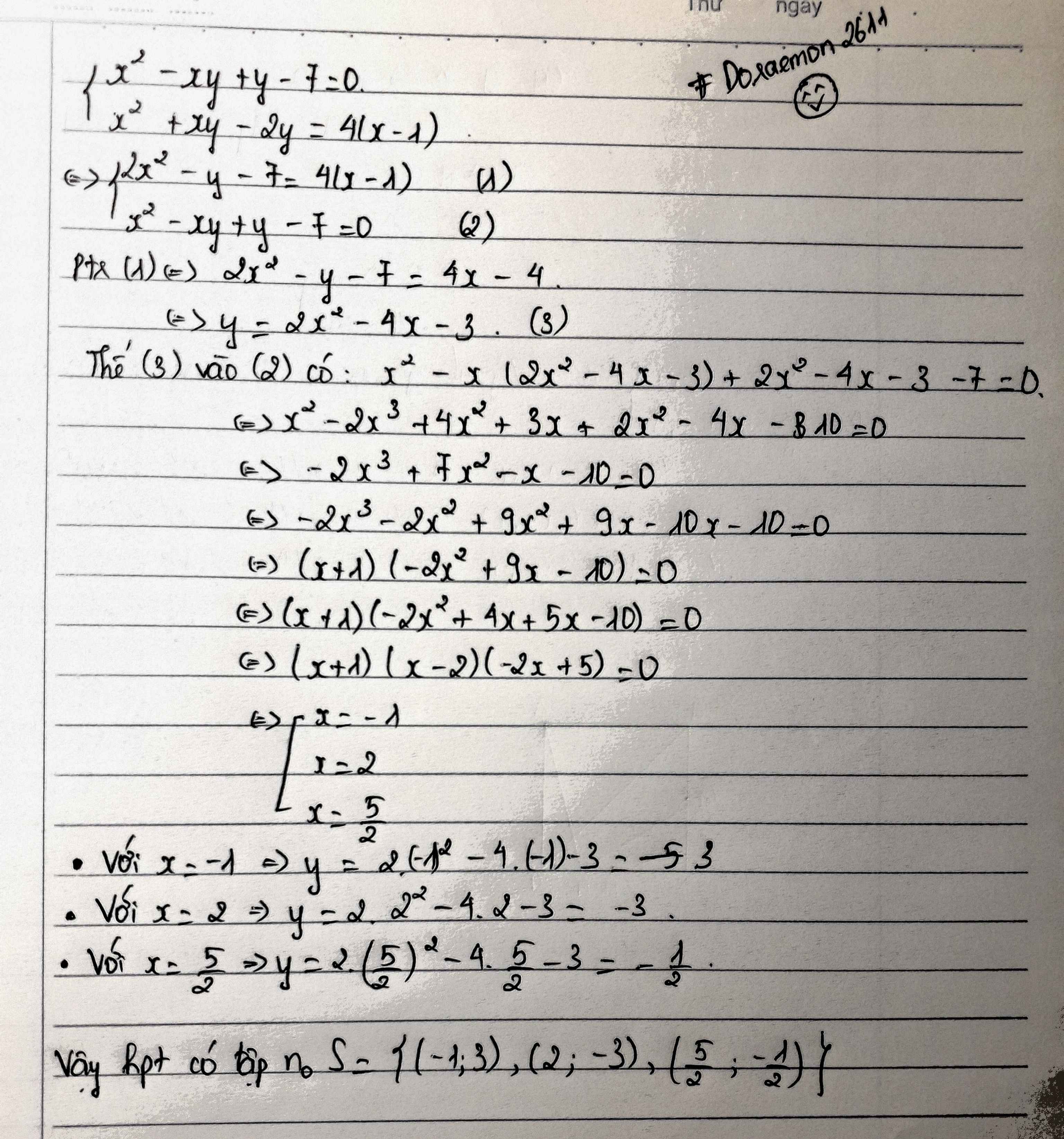Giải hệ phương trình sau: \(\left\{{}\begin{matrix}x^2y+2=y^2\\xy^2+2=x^2\end{matrix}\right.\)
Hãy nhập câu hỏi của bạn vào đây, nếu là tài khoản VIP, bạn sẽ được ưu tiên trả lời.


\(1,\Leftrightarrow\left\{{}\begin{matrix}x=y+5\\2y+10+y=11\end{matrix}\right.\Leftrightarrow\left\{{}\begin{matrix}x=\dfrac{16}{3}\\y=\dfrac{1}{3}\end{matrix}\right.\\ 2,\Leftrightarrow\left\{{}\begin{matrix}3x=1-2y\\1-2y+y=2\end{matrix}\right.\Leftrightarrow\left\{{}\begin{matrix}x=1\\y=-1\end{matrix}\right.\\ 3,\Leftrightarrow\left\{{}\begin{matrix}x=y+2\\3y+6+2y=11\end{matrix}\right.\Leftrightarrow\left\{{}\begin{matrix}x=3\\y=1\end{matrix}\right.\)

- Với \(x=0\) không phải nghiệm
- Với \(x\ne0\):
\(\Leftrightarrow\left\{{}\begin{matrix}x+y+\dfrac{y^2+1}{x}=2\\\left(x+y\right)^2-2\left(\dfrac{y^2+1}{x}\right)=-1\end{matrix}\right.\)
Đặt \(\left\{{}\begin{matrix}x+y=u\\\dfrac{y^2+1}{x}=v\end{matrix}\right.\)
\(\Rightarrow\left\{{}\begin{matrix}u+v=2\\u^2-2v=-1\end{matrix}\right.\)
\(\Rightarrow u^2-2\left(2-u\right)=-1\)
\(\Leftrightarrow u^2+2u-3=0\Rightarrow\left[{}\begin{matrix}u=1\Rightarrow v=1\\u=-3\Rightarrow v=5\end{matrix}\right.\)
\(\Rightarrow\) ... (bạn tự thế vào giải tiếp)

Biến đổi pt dưới:
\(x^2-4x+4+y\left(x-2\right)=0\)
\(\Leftrightarrow\left(x-2\right)^2+y\left(x-2\right)=0\)
\(\Leftrightarrow\left(x-2+y\right)\left(x-2\right)=0\)
\(\Leftrightarrow\left[{}\begin{matrix}x=2\\x=2-y\end{matrix}\right.\)
Thay vào pt đầu giải bt

Lời giải:
Lấy $x.\text{PT(1)}+y.\text{PT(2)}$ thu được:
$3x^3+y^3=-2x^2y^2$
Lấy $x.\text{PT(1)}-y\text{PT(2)}$ thu được:
$3x^3-y^3=4xy$
$\Rightarrow y^3=-x^2y^2-2xy$
PT (2)$\Leftrightarrow 2x^2y+2y^2=-4x$
$\Leftrightarrow 2x^2y+y(xy^2+3x^2)=-4x$
$\Leftrightarrow x[2xy+y(y^2+3x)]=-4x$
$\Leftrightarrow x(y^3+5xy)=-4x$
$\Leftrightarrow x=0$ hoặc $y^3+5xy=-4$
Nếu $x=0$ thì dễ tìm $y=0$
Nếu $y^3+5xy=-4$
$\Leftrightarrow -x^2y^2-2xy+5xy=-4$
$\Leftrightarrow -(xy)^2+3xy+4=0$
$\Leftrightarrow (4-xy)(xy+1)=0$
$\Leftrightarrow xy=4$ hoặc $xy=-1$
Nếu $xy=4$ thì:
$y^3=-4-5xy=-24\Rightarrow y=\sqrt[3]{-24}$
$x^3=\frac{y^3+4xy}{3}=\frac{-8}{3}\Rightarrow x=\sqrt[3]{\frac{-8}{3}}$ (tm)
Nếu $xy=-1$ thì:
$y^3=-4-5xy=1\Rightarrow y=1$
$x^3=\frac{y^3+4xy}{3}=-1\Rightarrow x=-1$ (tm)
Vậy..........

\(\Leftrightarrow\left\{{}\begin{matrix}2\left(x^2-2x\right)-\left(y^2-4y\right)=1\\\left(x^2-2x\right)^2+2=y\left(x-2\right)x\left(y-4\right)\end{matrix}\right.\)
\(\Leftrightarrow\left\{{}\begin{matrix}2\left(x^2-2x\right)-\left(y^2-4y\right)=1\\\left(x^2-2x\right)^2+2=\left(x^2-2x\right)\left(y^2-4y\right)\end{matrix}\right.\)
Đặt \(\left\{{}\begin{matrix}x^2-2x=u\\y^2-4y=v\end{matrix}\right.\)
\(\Rightarrow\left\{{}\begin{matrix}2u-v=1\\u^2+2=uv\end{matrix}\right.\) \(\Rightarrow u^2+2=u\left(2u-1\right)\)
\(\Leftrightarrow u^2-u-2=0\Leftrightarrow...\)

Lời giải:
Trừ 2 PT theo vế ta có:
$x^2y-xy^2=y^2-x^2$
$\Leftrightarrow x^2y-xy^2+x^2-y^2=0$
$\Leftrightarrow xy(x-y)+(x-y)(x+y)=0$
$\Leftrightarrow (x-y)(xy+x+y)=0$
$\Rightarrow x-y=0$ hoặc $xy+x+y=0$
Nếu $x-y=0\Leftrightarrow x=y$. Thay vào PT(1):
$x^3+2=x^2$
$\Leftrightarrow (x+1)(x^2-2x+2)=0$
$\Leftrightarrow (x+1)[(x-1)^2+1]=0$
Hiển nhiên $(x-1)^2+1>0$ nên $x+1=0$
$\Leftrightarrow x=-1$. Vậy $(x,y)=(-1,-1)$
Nếu $xy+x+y=0$
$\Leftrightarrow xy=-(x+y)$. Thay vào pt(1):
$x(-x-y)+2=y^2$
$\Leftrightarrow 2=x^2+xy+y^2=(x+y)^2-xy=(x+y)^2+(x+y)$
$\Leftrightarrow (x+y)^2+(x+y)-2=0$
$\Leftrightarrow (x+y-1)(x+y+2)=0$
$\Rightarrow x+y=1$ hoặc $x+y=-2$
Nếu $x+y=1$ thì $xy=-1$. Theo định lý Viet thì $x,y$ là nghiệm của $T^2-T-1=0$
$\Rightarrow (x,y)=(\frac{1+\sqrt{5}}{2}, \frac{1-\sqrt{5}}{2})$ và hoán vị
Nếu $x+y=-2$ thì $xy=2$. Theo định lý Viet thì $x,y$ là nghiệm của pt $T^2+2T+2=0$
Hiển nhiên pt này vô nghiệm nên loại
Vậy...........